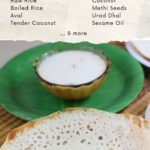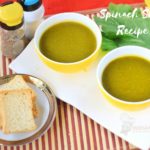Appam Recipe - Without Yeast
An Introduction To Appam Recipe without Yeast
Appam is a fluffy dosa made with fermented rice batter.
Appam is a traditional recipe that originated from the Indian subcontinent. It is famous in the states of Tamil Nadu, Karnataka, Kerala and Sri Lanka. It is a kind of fluffy dosa made with fermented rice batter. Though it may appear similar to dosa it differs both in taste and as well as texture from the regular dosa.
Difference between a dosa and an appam:
Dosa batter is made with rice and urad dhal mixed with a little methi seeds whereas appam batter requires some more ingredients like aval, tender coconut and coconut.
Appam is bowl shaped and dosa is absolutely flat. Appam is known for its fluffiness but dosa is famous for its crispiness. Dosa can be inverted and cooked on both the sides but appam cannot be flipped at all. Appam has its attractiveness in its pores while dosa looks good when smooth and plain.
Appachatti- A Reference:
You have a specific vessel for making this dish and it is called as appachatti in Tamil. It is shallow round shaped and looks similar to the regular kadai and has handle on both sides as you have to rotate the batter once you pour it in the appachatti.
Its texture:
It tastes extraordinary as it is fluffy and soft in the middle and crispy and crunchy at the corners. The golden brown edges with white spongy base filled with attractive pores all over make it all the more attractive and palatable. It is commonly served with vegetable stew, coconut milk or paya.
Its popularity:
It is liked my many people for its unique texture and shape and mostly people prefer it either for breakfast or for dinner. It is an ideal dish for kids and as well as elders as it is gluten-free. I remember eating appam with coconut milk on Sundays after a blissful oil bath, which would always be followed by a heavenly nap.
Appam without yeast:
There are many versions of making appam and one such version is this appam without adding yeast. Here I have added tender coconut instead of yeast and it will taste awesome. Let us see the method of preparing it easily with simple ingredients available.

Ingredients Required To Make Appam Without Yeast Recipe
How To Make Appam Without Yeast Recipe
Wash and clean the measured quantities of raw rice, boiled rice, urad dhal and methi seeds and add them in a vessel and pour four to five cups of water and soak them for three hours or more approximately.
After some time, drain the water and transfer them to a blender and add a cup of grated coconut and blend them into smooth batter by adding the required amount of water.
While blending, use tender coconut instead of water whenever necessary.
This gives the desired texture required to make the appam and it will also be delicious.
Transfer the smooth rice batter into a bowl and add the required salt.
Pour the remaining tender coconut and mix everything well and close the bowl with a lid.
Let it ferment for seven to eight hours approximately.
If you want to prepare appam for breakfast then let the batter ferment overnight.
Place the appakadai in the stove and keep it in high flame.
Let it get heated and meanwhile, you just take the appam batter and mix well using a ladle.
The batter should be absolutely smooth and in a free flowing consistency.
Grease the appakadai with a little oil and when it is heated just lower the flame.
Take a ladle of batter and pour it into the appakadai in the clockwise direction as we do it in the dosaikal (the tawa which we use to prepare dosa).
But here the ladle should not touch the appakadai at all. Instead, you hold the handles on both the sides in the appakadai and tilt in the clockwise direction, in order to spread the batter evenly.
Once it is spread in the appakadai, smear a quarter teaspoon of sesame oil around the batter and close it with a lid.
Throughout the process, let the flame be in low mode.
Once it is done, you can change it into medium mode so that the appam gets cooked.
After a minute, just open the lid and you will see the bottom being crispy and golden brown in colour.
The top will be fluffy and full of pores and now the tantalizing appam is ready.
Lower the flame and take it out from the appasatti using a dosa thiruppi ( specific spatula for taking out dosa and appam) and place it over a plate.
Similarly, cook a many appam as you want by adjusting the flame accordingly.
Serve it with chilled coconut milk or hot vegetable stew, the two popular vegan side-dishes for appam.
Things To Remember While Making Appam Without Yeast Recipe
- Instead of aval (puffed rice) you can also use sadam (cooked rice). We add these ingredients for softness.
- You can also use non-stick appa satti in case if you do not have the conventional one.
- You can also use any other cooking oil like groundnut oil and coconut oil for making appam. But you will need only a little oil for preparing appam.
- Grease the appa satti for each and every
- You should not flip the appam at any cost as the fluffiness on the top will be distorted if you flip.
- As we close the appa satti with a lid the top portion will get cooked well.
- You can store the remaining appam batter in fridge and reuse it for two to three days.
- There are quite a few versions of appam that differ from each other in ingredients but the preparatory method remains almost the same everywhere.
Ingredients
Directions
Wash and clean the measured quantities of raw rice, boiled rice, urad dhal and methi seeds and add them in a vessel and pour four to five cups of water and soak them for three hours or more approximately.
After some time, drain the water and transfer them to a blender and add a cup of grated coconut and blend them into smooth batter by adding the required amount of water.
While blending, use tender coconut instead of water whenever necessary.
This gives the desired texture required to make the appam and it will also be delicious.
Transfer the smooth rice batter into a bowl and add the required salt.
Pour the remaining tender coconut and mix everything well and close the bowl with a lid.
Let it ferment for seven to eight hours approximately.
If you want to prepare appam for breakfast then let the batter ferment overnight.
Place the appakadai in the stove and keep it in high flame.
Let it get heated and meanwhile, you just take the appam batter and mix well using a ladle.
The batter should be absolutely smooth and in a free flowing consistency.
Grease the appakadai with a little oil and when it is heated just lower the flame.
Take a ladle of batter and pour it into the appakadai in the clockwise direction as we do it in the dosaikal (the tawa which we use to prepare dosa).
But here the ladle should not touch the appakadai at all. Instead, you hold the handles on both the sides in the appakadai and tilt in the clockwise direction, in order to spread the batter evenly.
Once it is spread in the appakadai, smear a quarter teaspoon of sesame oil around the batter and close it with a lid.
Throughout the process, let the flame be in low mode.
Once it is done, you can change it into medium mode so that the appam gets cooked.
After a minute, just open the lid and you will see the bottom being crispy and golden brown in colour.
The top will be fluffy and full of pores and now the tantalizing appam is ready.
Lower the flame and take it out from the appasatti using a dosa thiruppi ( specific spatula for taking out dosa and appam) and place it over a plate.
Similarly, cook a many appam as you want by adjusting the flame accordingly.
Serve it with chilled coconut milk or hot vegetable stew, the two popular vegan side-dishes for appam.










